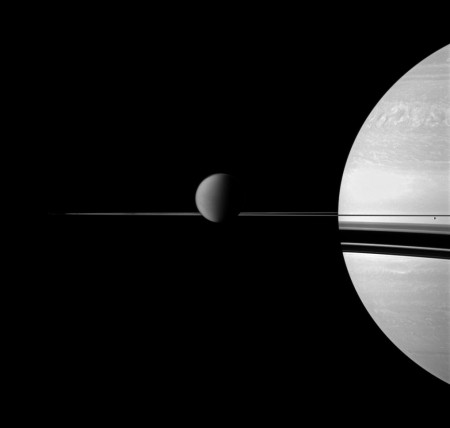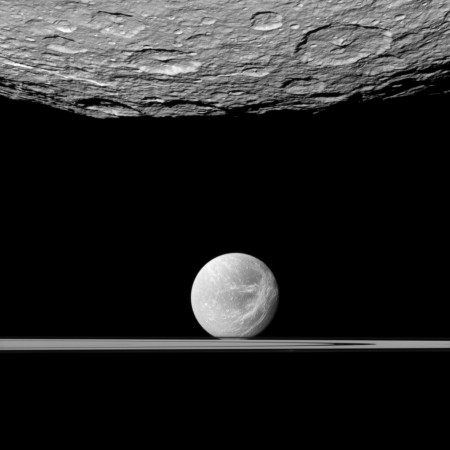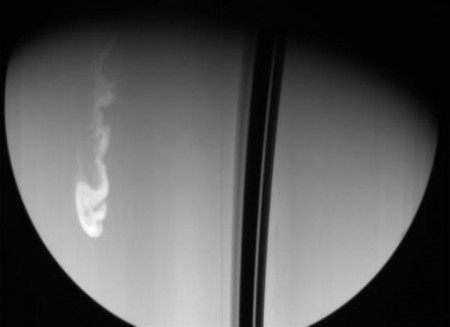#March2011
Saturn’s Rings Are Slicing Titan’s Throat.
Enlarge. | Via.
That’s Saturn’s moon, Titan. Straight chillin’, balancing on top of Saturn’s gorgeous rings. Sort of. The powers of perspective, summoned! Consummated. But what is really interesting is how fucking thin Saturn’s rings are. Something I don’t really stop and contemplate. Well, I don’t contemplate much, but that’s obvious.
Saturn’s Moon Rhea Takes A Beautiful Picture; Dione Isn’t Shabby Either.
Saturn’s Great White Spot Is A Thousand-Mile Storm. Spacesplooge.
[Enlarge.]
Everyone knows about Jupiter’s Red Spot. And for good reason, ’cause it’s goddamn impressive. But did you know that Saturn has its own friggin’ insane spot? Not to be outdone by its solar system brethren, Saturn has a Great White Spot that is a thousand-mile storm.
The Great White Spot is the lesser known, Saturnian equivalent of Jupiter’s Great Red Spot. It’s the name given to periodic storms that flare up about every 28.5 years, previously showing up in 1876, 1903, 1933, 1960, and 1990. As such, we shouldn’t be expecting another appearance until around 2018, although huge, Spot-like storms do occasionally show up at times that don’t fit the cycle, including 1994 and 2006.
G’damn! Thanks to a new image by the Cassini probe taken on Christmas Eve, we may have an insane image of another occurrence:
torms like these are thought to be created by thermal instability, which throws up tons of material from the planet’s lower atmosphere up into the higher regions. When these storms overlap with the turning of Saturn’s seasonal cycle every 28 or so years, the storm becomes so massive that it can encircle the entire planet, creating the Great White Spot.
[cont]
Technically speaking, we don’t know yet whether this particular storm will develop into a full-fledged Great White Spot. Of course, even if it doesn’t technically qualify for “great” status, we’re still talking about a storm system that you could fit this week’s northeastern blizzard into a dozen times over.
If that shit isn’t mindblowing enough, Bad Astronomy puts it into even crazier perspective:
This image, taken with a blue filter, shows the storm clearly. The main spot is huge, about 6,000 km (3600 miles) across – half the size of Earth! Including the tail streaming off to the right, the whole system is over 60,000 km (36,000 miles) long.
Whether this is a new iteration of the son of a bitch Great White Spot, or just an enormous storm enough to send me into a full-blown existential crisis, it’s goddamn gorgeous.








